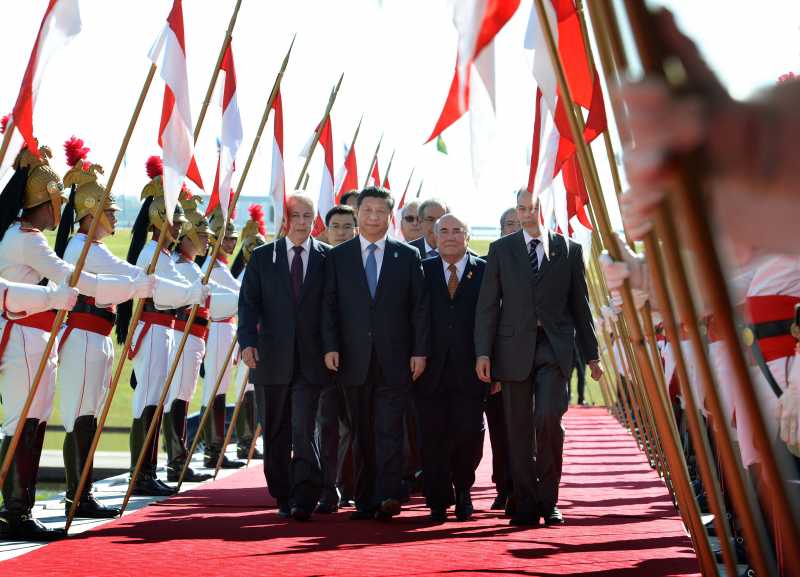Amit Kapoor and Sankalp Sharma review the BRICS summit held in Brazil

The recently concluded BRICS annual summit held in Brazil resulted in the important Fortaleza Declaration and Action Plan from the leaders of Brazil, Russia, India, China and South Africa. The joint declaration has some important points that highlight the importance of this year’s summit.
The most important point of the summit seems to be the establishment of the New Development Bank (NDB) with the purpose of “mobilizing resources for infrastructure and sustainable development projects in BRICS and other emerging and developing economies”. The bank would have an initial authorized capital of $100 billion with the initial subscribed capital of $50 billion equally shared among the founding members.
The first chair of the Board of Governors is slated to be from Russia, chair of the Board of Directors from Brazil, President of the bank from India with its headquarters in Shanghai. The New Development Bank Africa Regional Center is to be established in South Africa concurrently with the headquarters. This way the functioning of the bank is thus expected to be democratic.
The summit has also announced the signing of the Treaty for the establishment of the BRICS Contingent Reserve Arrangement (CRA) with an initial size of $100 billion. The fundamental purpose is to further BRICS cooperation, strengthen the global financial safety net and help member countries forestall short-term liquidity pressures.
The establishment of the New Development Bank has had mixed reactions, with some hailing it as a threat to the hegemony of the Bretton Woods twins – the World Bank and the IMF – and others viewing it as a positive development which would help the BRICS and indeed other emerging market and developing economies (EMDEs) in achieving their real potential. It is a small step forward, as The Economist would also agree, given that Brazilian Development Bank lent $88 billion in 2013 with its Chinese counterpart disbursing loans of $240 billion. It is clearly brought to perspective when we look at World Bank estimates which point to South Asia alone requiring $2.5 trillion in infrastructure spends over the next 10 years. So a $100 billion bank will clearly not be enough to fund all the requirements of BRICS. China is already proposing an Asian Infrastructure Investment Bank with initial capital of $50 Billion. However, the NDB appears at present as a small step in the right direction.
It can hardly be believed from the Fortaleza Declaration that the construct itself was envisaged, and the acronym BRICS (South Africa was not part of the original construct) coined just 13 years ago in 2001. The initial reason for framing the construct was to discern the rise in global power of the emerging countries which would reshape the World economy by 2050.
Some would argue that the construct in itself is not very robust essentially because of the diversity of the countries clubbed together. The population of the largest China (1.35 billion) is approximately 26 times that of the smallest South Africa (52 million). Similarly the territory of the largest – Russia – (17,098,000 sq km) is more than 14 times larger than the smallest – South Africa at 1,221,000 sq km). The biggest economic size – China at $9.185 trillion (2013) – has a GDP almost 24 times that of the smallest – South Africa at $382 billion (2012). The biggest per capita GDP of the most prosperous Russia ($14,604 in 2013) is approximately 10 times that of the least affluent India ($1,418 in 2013).
The essential argument is that BRICS share nothing apart from economic growth rates – be it their economic geography (three of them are neighbors in Asia while the other two lie in two different continents (South Africa in Africa and Brazil in South America), their language, culture or even their political systems (three – Brazil, India and South Africa – are democracies while two – Russia and China – are authoritarian regimes in some form or the other. It is all indeed very true except that post the coinage of the acronym these countries have somehow tried to share and cooperate in matters which are urgent and necessary for their economies. They can, at times, be seen as uncomfortable brethren who are compelled to work together.
The next summit is slated to be in Ufa in Russia in 2015. At the operational level, some things will certainly take shape by then. However, will the BRICS emerge as a stronger construct over a long time frame (till 2050) or will it wither away as an economic construct? That only time can tell. As of now, it surely is “Dreaming With BRICS” with the establishment of the NDB.